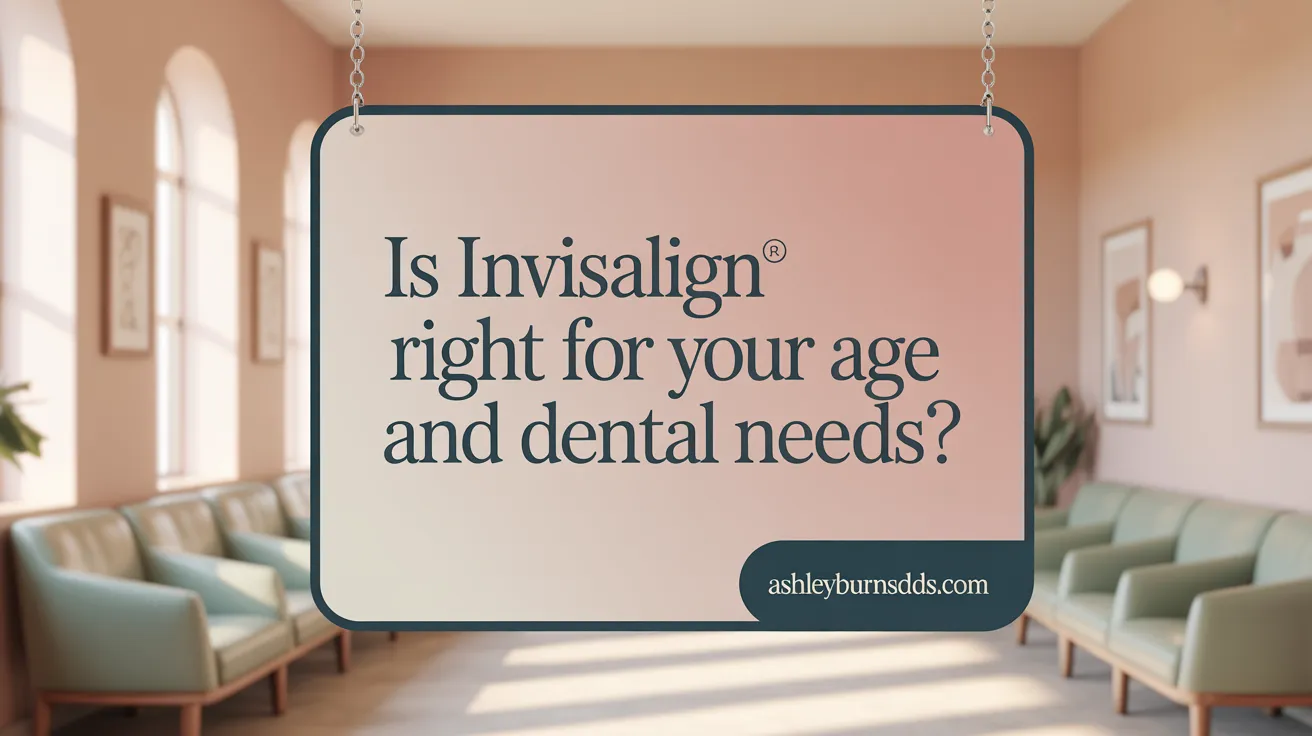A New Era in Orthodontics: Invisalign's Clear Solution
Invisalign has transformed the landscape of orthodontic treatment by providing a discreet, comfortable, and effective alternative to traditional metal braces. Combining cutting-edge technology and advanced materials, Invisalign offers patients a personalized and convenient solution to achieve a straighter smile without the aesthetic and practical drawbacks of braces. This article explores how Invisalign works, its treatment process, comparisons with traditional braces, benefits, costs, and suitability across different age groups and dental conditions.
The Science and Mechanics Behind Invisalign
 Invisalign achieves teeth straightening through a combination of cutting-edge materials, digital technology, and biological processes. The core of its effectiveness lies in the use of custom-made, clear aligners crafted from a proprietary thermoplastic material called SmartTrack®. This advanced material is designed for flexibility, strength, and predictability, ensuring that each set of aligners applies the right amount of force to move teeth gradually.
Invisalign achieves teeth straightening through a combination of cutting-edge materials, digital technology, and biological processes. The core of its effectiveness lies in the use of custom-made, clear aligners crafted from a proprietary thermoplastic material called SmartTrack®. This advanced material is designed for flexibility, strength, and predictability, ensuring that each set of aligners applies the right amount of force to move teeth gradually.
The treatment begins with a detailed digital assessment. Using high-tech equipment like the iTero scanner, the orthodontist creates a precise 3D digital model of the patient’s teeth. This digital impression forms the basis for a meticulously planned treatment pathway, which is mapped out using special software ClinCheck®. This plan predicts the step-by-step movement of teeth into their ideal position and serves as a visual guide for both the provider and the patient.
Once the treatment plan is finalized, a series of aligners are manufactured. Each aligner fits snugly over the teeth and is worn typically for one to two weeks before being replaced with the next in the series. This incremental change exerts gentle, controlled pressure on specific teeth, guiding them closer to their final aligned position.
The biological foundation of this process involves the periodontal ligament—a flexible tissue connecting teeth to surrounding bone. When an aligner applies pressure, it stimulates the periodontal ligament to initiate a natural process called bone remodeling. Under this biomechanical influence, bone tissue on the pressure side resorbs, or breaks down, while new bone forms on the tension side. This biological response effectively shifts the teeth while preserving periodontal health.
The combination of scientifically engineered aligner technology, precise digital planning, and natural biological bone adaptation allows Invisalign to provide an effective, discreet, and comfortable method for teeth straightening. Patients benefit from a treatment that is not only aesthetically appealing but also grounded in a deep understanding of dental biomechanics.
Step-by-Step Invisalign Treatment Process
The Invisalign treatment starts with an initial consultation with an orthodontist or dentist. During this appointment, the practitioner assesses your oral health and determines if Invisalign is suitable for your case. They use advanced technology like the iTero 3D scanner to capture detailed images of your teeth, replacing traditional molds with digital impressions.
Once the digital scan is completed, a personalized treatment plan is developed. This plan maps out the precise movements needed to straighten your teeth and predicts the treatment timeline. Using specialized software, the orthodontist designs a series of custom aligners tailored to your teeth's unique structure.
The next step involves the fabrication of these aligners. Small, BPA-free plastic trays are created using 3D printing, ensuring each set gradually moves your teeth into better alignment. Typically, you'll receive several sets of aligners at once, each meant to be worn for one to two weeks.
Wearing your aligners consistently is crucial. You should aim to wear them 20 to 22 hours daily, removing them only when eating, drinking other than water, or cleaning your teeth. Regular adherence to this schedule fosters healthy, predictable tooth movement.
Throughout your treatment, periodic check-ups with your orthodontist are scheduled every 6 to 8 weeks. These visits allow your provider to monitor progress, make any necessary adjustments, and provide new aligners. Sometimes, refinements or additional sets may be needed to fine-tune the results.
After completing the active phase of treatment, wearing a retainer—such as the Vivera retainer—is essential. This device helps maintain your new smile and prevents teeth from shifting back. Retainers are typically worn full-time initially, then reduced to nighttime use, ensuring long-term stability.
Overall, the Invisalign process offers a discreet, comfortable, and effective way to straighten teeth, with a well-structured plan and regular professional oversight ensuring optimal results.
Comparing Invisalign with Traditional Braces and Other Orthodontic Options
Invisalign and traditional braces are both effective orthodontic treatments but differ significantly in their materials, appearance, and functionality. Invisalign uses transparent, BPA-free plastic aligners made from SmartTrack material, making them nearly invisible when worn. In contrast, traditional braces consist of metal brackets and wires bonded to the teeth, which are highly visible and often considered less discreet (Braces vs clear aligners).
One of the main advantages of Invisalign is its removability. Patients can take out aligners for eating, cleaning, and social occasions, which simplifies maintaining oral hygiene and allows for a broader diet without restrictions. Traditional braces, however, are fixed appliances that require careful cleaning and dietary limitations to prevent damage (Invisalign vs metal braces).
When it comes to treating complex cases, traditional braces generally have the edge. They exert more precise and stronger forces necessary for severe misalignments, jaw corrections, and significant tooth movements. Invisalign, while highly effective for mild to moderate issues, may struggle with complex corrections unless auxiliaries like attachments are used (Invisalign limitations, Attachments in Invisalign).
Treatment duration and frequency of visits also differ. Invisalign typically shortens treatment time to around 12-18 months, with less frequent visits (every 6-8 weeks) for check-ups and new aligners. Traditional braces often require 18-24 months of continuous wear and more frequent adjustments, often monthly (Invisalign treatment duration, Braces vs Invisalign treatment time).
Comfort and aesthetic appeal are other important factors. Invisalign’s smooth plastic aligners cause less mouth irritation and are preferred for their discreet look. They are especially popular among adults and teens concerned about appearance. Braces can cause discomfort, mouth sores, and aesthetic concerns due to their visibility (Invisalign benefits, Invisalign vs braces pros and cons).
Despite its many advantages, Invisalign has some limitations. It may not be suitable for severe orthodontic cases needing jaw surgery or extensive tooth movement. Also, patient compliance is crucial; aligners must be worn most of the day, or treatment effectiveness can be compromised (Invisalign compliance).
In summary, Invisalign offers a more aesthetic and convenient orthodontic solution with a shorter treatment period and less discomfort, making it ideal for mild to moderate issues and adult patients. Traditional braces remain the preferred choice for complex cases where maximum control and force application are required. Options like ceramic and lingual braces provide alternative aesthetic treatments but come with their own considerations (Invisalign vs braces comparison, Types of braces).
Benefits and Health Advantages of Invisalign Over Braces

What are the benefits and health advantages of Invisalign compared to traditional braces, considering cosmetic, comfort, and oral health factors?
Invisalign offers notable cosmetic benefits due to its nearly invisible, clear plastic aligners, making it highly discreet and attractive for adults and teens concerned about their appearance during treatment (Invisalign clear aligners, Invisalign appearance and comfort).
Because the aligners are removable, patients find it easier to maintain good oral hygiene; they can brush and floss normally without the obstacle of brackets and wires that traditional braces have. This reduces the risk of plaque buildup, cavities, and gum disease during orthodontic treatment (oral hygiene with Invisalign, oral hygiene with braces.
Comfort is another significant advantage. Invisalign aligners are made from smooth, BPA-free material, which minimizes cheek and gum irritation often caused by metal brackets or wires. Their customization ensures a snug fit, further enhancing comfort (SmartTrack proprietary material, Comfort and Control with Invisalign).
In addition to comfort and hygiene, Invisalign treatment results in fewer emergency visits. There's a lower likelihood of broken brackets or wires requiring urgent orthodontic attention, which can be common with traditional braces (fewer emergency visits with Invisalign).
Dietary freedom is also a major health-related benefit. Unlike braces that restrict certain hard, sticky, or chewy foods to prevent damage, Invisalign aligners can be removed during meals, allowing patients to eat whatever they like without worry (Invisalign dietary flexibility, Diet and Invisalign).
Long-term oral health benefits include a reduced risk of dental issues like decay and gum disease, as proper cleaning is easier and more effective. Furthermore, aligning teeth properly decreases abnormal wear, eases chewing, and reduces strain on jaw joints and muscles, promoting overall better oral health (Benefits of Invisalign, Straighter teeth benefits).
While traditional braces are highly effective, especially for severe cases (Advantages of braces, Invisalign provides a balanced combination of aesthetic appeal, comfort, hygiene convenience, and long-term health advantages, making it a preferred option for many patients seeking orthodontic correction (Invisalign vs braces comparison, Advantages of clear aligners).
Cost of Invisalign: Factors, Average Range, and Payment Options
 The expense of Invisalign treatment varies based on several factors, with prices typically falling between $3,000 and $8,000. Key influencers include the complexity of the case, the length of treatment, geographic location, and the experience level of the provider. More straightforward cases generally incur lower costs, whereas complex or extended treatments may push expenses higher.
The expense of Invisalign treatment varies based on several factors, with prices typically falling between $3,000 and $8,000. Key influencers include the complexity of the case, the length of treatment, geographic location, and the experience level of the provider. More straightforward cases generally incur lower costs, whereas complex or extended treatments may push expenses higher.
Insurance plans often provide partial coverage for Invisalign, commonly reimbursing up to around $3,000. The actual amount covered depends on the patient's individual insurance policy, with some plans offering between $1,500 and $3,500. Patients should check with their insurance providers beforehand to understand their specific benefits and coverage limits (Invisalign insurance and payment plans).
Utilizing tax-advantaged accounts such as Health Savings Accounts (HSAs) and Flexible Spending Accounts (FSAs) can help offset treatment costs. These accounts allow you to pay for eligible dental and orthodontic expenses with pre-tax dollars, reducing the overall financial burden (Flexible Invisalign payment options).
Invisalign providers typically offer flexible payment plans and financing options. Many clinics have in-house schemes with low or zero-interest installment plans. Additionally, third-party lenders like CareCredit are often accepted, enabling patients to spread payments over several months (CareCredit Invisalign financing). Some providers may also offer discounts for full upfront payments or multiple family members undergoing treatment.
Beyond the aligners, there may be additional costs such as retainers, refinement trays, or replacement aligners, which can range from a few hundred to over a thousand dollars. It’s wise to discuss all potential expenses during your consultation (Vivera retainers and refinements).
To manage overall costs effectively, patients should verify their insurance benefits, inquire about available payment plans, and seek quotes from multiple qualified Invisalign providers. Choosing experienced orthodontists or dentists with a high case volume may also influence both the quality and the cost of treatment, ensuring better results within your budget (Invisalign provider expertise).
Suitability of Invisalign for Different Ages and Dental Cases

Is Invisalign suitable for different age groups and specific dental cases?
Invisalign has become a popular choice for a broad spectrum of patients, ranging from children to adults. It is especially designed to be versatile, with specific treatments tailored to various age groups and dental needs.
For teenagers and adults, Invisalign clear aligners are highly effective for treating mild to moderate orthodontic issues such as crowding, gaps, overbites, underbites, and crossbites. Its discreet, nearly invisible aligners are particularly attractive to individuals concerned about appearance during treatment.
There are also specialized Invisalign products like Invisalign for kids, such as Invisalign First, which is designed for children aged 6 and older. This version caters to growing mouths and emerging molars, offering a proactive approach to orthodontic correction in younger patients.
However, the suitability of Invisalign diminishes in cases of severe or complex dental problems. Traditional braces or other orthodontic methods might be necessary to achieve optimal results in these situations because Invisalign removable aligners benefits have limitations in comprehensively controlling advanced tooth movements.
Dental health also plays a crucial role in candidacy. Patients must have healthy gums and teeth to start treatment. Those with active gum disease or significant cavities are advised to resolve these issues before proceeding with Invisalign.
Patient compliance remains vital. For best results, wear aligners 20-22 hours daily, making discipline the cornerstone for successful treatment, especially among teens and busy adults.
To determine proper suitability, a thorough dental examination—including X-ray assessments and 3D scan with doctor—is essential. These evaluations help practitioners understand individual cases, ensuring Invisalign can effectively meet the patient’s needs while considering age and dental maturity.
Scientific Evidence and Choosing the Right Orthodontic Treatment
What scientific evidence supports the effectiveness of Invisalign as an orthodontic treatment?
Clinical research and systematic reviews affirm that Invisalign is effective in treating mild to moderate malocclusions. Studies show that its outcomes can match traditional braces in appropriate cases, thanks to advances in digital modeling, material science, and software design. The use of SmartTrack aligners and precise treatment planning contributes to predictable, efficient tooth movement. Nevertheless, the success of Invisalign heavily depends on patient adherence to wearing aligners for the recommended 20 to 22 hours daily. Its effectiveness may be limited in complex cases involving significant bite issues or severe overcrowding, where traditional braces often provide more controlled and powerful force application.
What considerations should be taken into account when choosing between Invisalign and other orthodontic treatments based on personal needs and preferences?
Deciding between Invisalign and other treatments requires evaluating multiple factors. For mild to moderate misalignments, Invisalign offers a discreet, removable, and generally more comfortable option. Its aesthetic benefits—nearly invisible trays—are ideal for adults and teens concerned about appearance. Conversely, traditional braces are more suitable for complex dental corrections, providing stronger and precise control over tooth movement. Cost considerations also influence decision-making; Invisalign typically ranges from $3,000 to $8,000, while braces may be slightly less or comparable depending on the case complexity. Treatment durations vary, with Invisalign averaging 12-18 months and braces sometimes taking longer. Personal lifestyle, discipline, and comfort preferences should be carefully weighed. Failing to wear aligners as prescribed can compromise the outcome, underscoring the importance of patient responsibility.
In summary, a professional consultation with an experienced orthodontist is essential to assess the specific dental needs, aesthetic goals, and lifestyle considerations, ensuring an informed treatment choice that aligns with individual preferences and orthodontic requirements.
Making the Clear Choice: Invisalign's Role in Modern Orthodontics
Invisalign represents a significant advancement in orthodontic care, providing patients with a discreet and comfortable option that aligns well with contemporary lifestyles. Its innovative use of clear, custom-fit aligners and digital treatment planning ensures effective results for a wide range of mild to moderate dental issues. While traditional braces remain indispensable for complex cases, Invisalign's benefits in aesthetics, convenience, and oral health maintenance make it an attractive alternative for many. Choosing the right treatment requires careful consideration of individual dental needs, lifestyle preferences, and compliance abilities, ideally under professional guidance. Ultimately, Invisalign's science-backed approach and patient-centered design make it a clear contender in the journey toward a healthier, more confident smile.
